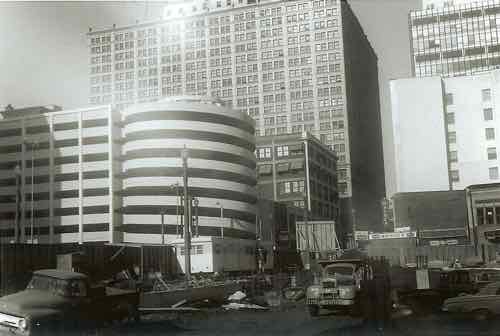An argument in favor of shared parking
Last Sunday I was walking from my place to the London Tea Room. I went the long way to look at old cars lined up on 17th for the Veteran’s Parade. So I crossed through CPI’s parking lot which is just North of my building.
I noticed a driver get into an SUV after pulling two notes off the window. Pulling away I saw the car pictured above with the same notes. Basically CPI doesn’t like residents from surrounding buildings parking on their lot overnight. I was very pleased to see the notes could be easily removed rather than those requiring elbow grease and a razor blade.
But it brings up a question about how we use our land. The above image shows their parking lot thinning about 4pm on Monday. Washington Ave runs left to right in the background. !7th Street and CPI’s building are on the left. This is one of four parking lots for CPI.
The parking lot continues over to 16th Street (right). The massive Ely-Walker building is across 16th. It has underground garage parking but I think some residents have more than one car per unit.
What I’d like to see is shared use of the lot. For a fee, a fixed number of residents could be allowed to use CPI’s lot from 5pm -7am weekdays and 24/7 on weekends. I hate seeing this lot sit mostly vacant evenings and weekends.
Ideally CPI would do well to explore ways to reduce the number of employee’s vehicles each day. Offer employee’s $25/month if they didn’t bring their car to work. This would prompt some to look at transit or carpooling.  The money paid out to employee’s would come in from fees collected from others using the parking on off hours.
A CPI-sponsored WeCar vehicle (car sharing from Enterprise) could help employees that use transit or carpool if they need a car to run errands at lunch. The many residents living in this part of downtown might become members as well. The nearest WeCar to us is 7-8 blocks away. With a close WeCar some 2-car households might drop down to one and some one-car households might go to zero. A sponsor covers the cost each month if a vehicle is not rented by members often enough each month.
Promotional video from Enterprises’ WeCar program:
httpv://www.youtube.com/watch?v=xDhHo3bJ9bM
Know that I’m not picking on CPI — they are a good neighbor. I’m just suggesting ways in which they might alter how they view the land around their building used for car storage.
– Steve Patterson











